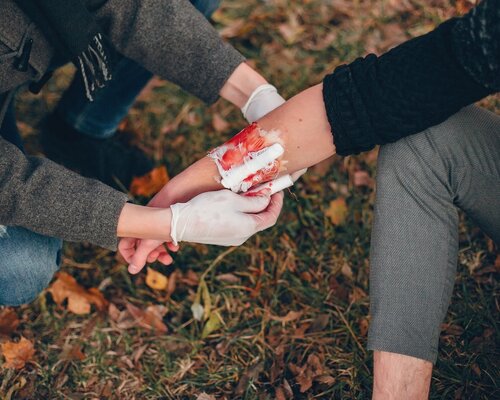Causes
Burns occur mainly at home and can be caused by:
- Car accidents
- Not properly sealed hot water bottles
- Electricity burns from faulty appliances
- Touching hot surfaces such as stoves and irons
- Spillage of hot liquids such as tea, coffee or soup (especially in children)
- Unsafe use of fireworks
- Careless use of kindling at a barbecue
- Careless handling of electrical appliances
- Detecting gas leaks with a lit match (use soap solution)
- Playing with matches
- Running away with a burning pan
- Clothes catching fire from falling asleep with a lit cigarette
- Working with flammable substances near a flame
- Bath water too hot (always check with the elbow)
- Too warm pitchers (dangerous in paralyzed patients)
Symptoms to Skin and Mucous membranes
- Skin: Redness, gray- to yellowish-white or black skin, scaling, blistering (with clear liquid), pain (not always indicative of severity), swelling, nausea and/or vomiting, shock (pale and clammy skin, weakness, blue lips and nails, decrease in alertness) due to fluid loss.
- Mucous membranes/Airways: Burns from inhalation of smoke, steam or chemical vapors, dark or black mucus, burned lips and mouth, voice changes, wheezing, difficulty breathing, coughing.
Lightning strike
Lightning strikes can cause typical burns with the appearance of a fern leaf. Patients are often briefly unconscious and may subsequently experience speech problems, confusion, memory loss, hearing and vision problems. Cardiac arrhythmias or cardiac arrest may also occur. After impact, the current is gone and the patient can be safely touched.
Severity of Burn
The severity of a burn is determined by:
- General condition of the patient: Children under four years of age and the elderly have a higher risk of complications and death.
- Depth of wound: First-degree, second-degree or third-degree burns.
- Patient's clothing: Natural fabrics burn without residue, synthetic fabrics burn into the skin.
- Location of burn: Face, hands, feet and genitals are particularly vulnerable.
- Extent of burn: Based on percentages of body surface area.
- Burning Cause: Steam, chemicals and contact with hot objects or fire.
First Aid: Cooling with Water
- Minor burns: Cool the wound immediately with cold to lukewarm running water (not ice water!) for at least five to 15 minutes. Then use a clean, cold, wet towel to reduce pain. Cover the wound with a dry, sterile dressing or clean dressing. Use painkillers such as ibuprofen or paracetamol and moisturizing lotion after cooling.
-
Larger burns: Have the patient stand still, lie on the floor and roll near burning clothes. Use thick materials to extinguish the flames and then pour copious amounts of water over the patient. Call emergency services immediately. Check breathing and begin CPR if necessary. Cover the burn with a dry sterile dressing or clean cloth. Remove jewelry and elevate the burned body part if possible. Do not touch the patient directly in electricity-related burns.
First Aid: What Definitely Don't Do
- Clothing: Do not let people walk with burning clothes. Do not use nylon material to extinguish flames. Do not remove clothing that sticks to skin.
- Cooling: Do not use cold water or ice to prevent hypothermia and shock.
- Care: Do not use ointment, butter, ice, medication, oil, or other household products. Do not breathe, blow or cough on the burn. Do not puncture blisters or dead skin.
- Food and drink: Do not give food or drink to severely burned patients to avoid choking and complications from possible surgery.
In case of persistent symptoms or severe burns, it is important to always seek medical attention.





